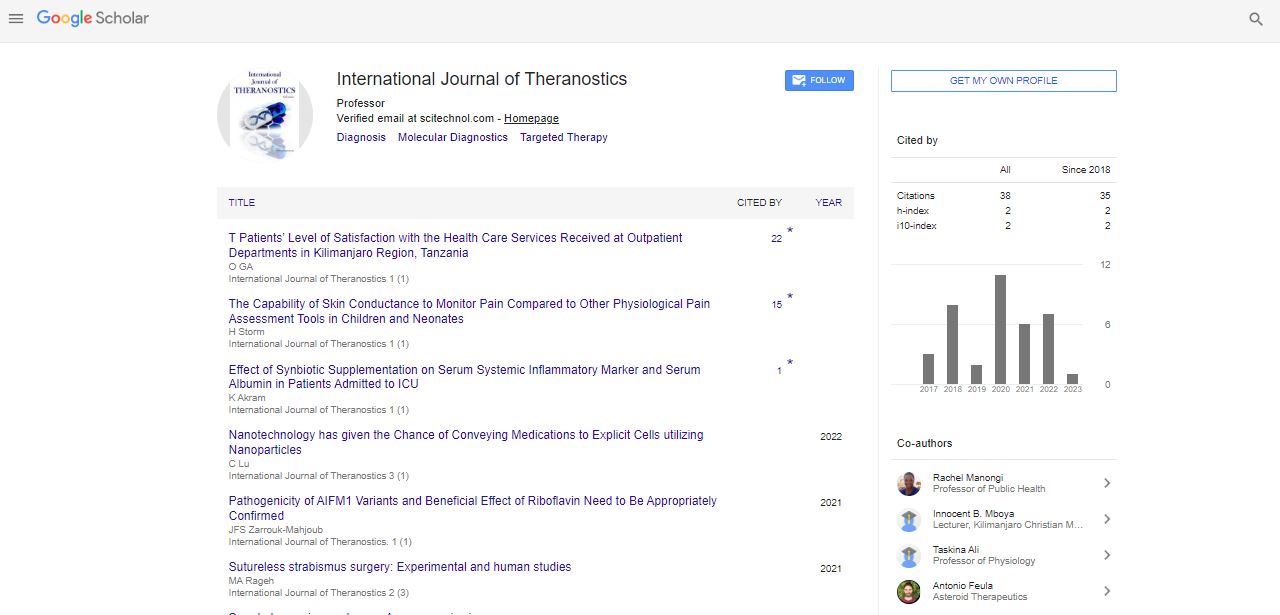Commentary, Int J Theranostic Vol: 12 Issue: 4
Theranostics in Infectious Disease: Charting a Course through Challenges, Embracing Opportunities
Khadijeh Bednan*
1Department of Nuclear Medicine, University of Duesseldorf, Duesseldorf, Germany
*Corresponding Author: Khadijeh Bednan,
Department of Nuclear Medicine,
University of Duesseldorf, Duesseldorf, Germany
E-mail: Khadijehbednan324@uhdhu.de
Received date: 27 November, 2023, Manuscript No. IJT-23-124070;
Editor assigned date: 29 November, 2023, PreQC No. IJT-23-124070(PQ);
Reviewed date: 14 December, 2023, QC No. IJT-23-124070;
Revised date: 21 December, 2023, Manuscript No. IJT-23-124070(R);
Published date: 28 December, 2023, DOI: 10.4172/IJT.1000149.
Citation: Bednan K (2023) Theranostics in Infectious Disease: Charting a Course through Challenges, Embracing Opportunities. Int J Theranostic 12:5.
Description
The intersection of diagnostics and therapeutics, known as theranostics, has witnessed significant advancements in recent years, offering a promising paradigm for the diagnosis and treatment of infectious diseases. This essay explores the challenges and opportunities associated with employing theranostic approaches in infectious disease management. By combining diagnostic capabilities with targeted therapeutic interventions, theranostics presents a multifaceted strategy to address the complex nature of infectious diseases.
Infectious diseases often require rapid and accurate detection to initiate timely treatment and prevent the spread of the pathogen. However, traditional diagnostic methods may be time-consuming and labor-intensive. Developing theranostic platforms that offer quick and precise identification of infectious agents is crucial for effective disease control.
Infectious diseases are caused by a myriad of pathogens, including bacteria, viruses, fungi, and parasites. Each type of pathogen may necessitate a distinct diagnostic approach. Theranostic strategies must be versatile enough to accommodate the diversity of infectious agents, ensuring broad applicability across various pathogens. Access to sophisticated diagnostic tools may be limited in certain regions, particularly in resource-constrained settings. Theranostic approaches need to be designed for point-of-care applications, enabling on-site testing and immediate decision-making, especially in the early stages of infectious diseases when prompt intervention is crucial.
Theranostics in infectious diseases can leverage molecular diagnostic techniques, such as Polymerase Chain Reaction (PCR) and nucleic acid amplification, for highly sensitive and specific pathogen detection. Molecular approaches enable the identification of genetic material unique to the infectious agent, allowing for early and accurate diagnosis.
Advanced imaging technologies, including Positron Emission Tomography (PET) and Magnetic Resonance Imaging (MRI), can be integrated into theranostic approaches for infectious diseases. These technologies enable non-invasive visualization of infected tissues and organs, aiding in disease staging and treatment planning. Nanotechnology and biosensors offer opportunities for the development of highly sensitive and selective diagnostic tools. Nanoparticles and nanoscale materials can be engineered to detect specific biomarkers associated with infectious agents, providing rapid and reliable diagnostic information.
The rise of antibiotic resistance poses a significant challenge in the treatment of bacterial infections. Theranostic approaches need to account for the evolving resistance patterns of infectious agents, necessitating the development of targeted therapies that consider individual resistance profiles. Viruses, particularly RNA viruses like influenza and HIV, exhibit high mutation rates, leading to the emergence of new strains. Theranostic strategies must address the dynamic nature of viral genomes and adapt to evolving strains to maintain therapeutic efficacy. Host immune responses vary among individuals, impacting the effectiveness of therapeutic interventions. Theranostic approaches need to consider the host's immune profile, tailoring treatment strategies to enhance the natural defense mechanisms and optimize therapeutic outcomes.
The integration of theranostics allows for personalized treatment strategies based on individual patient characteristics. By considering the specific infectious agent, its resistance profile, and the host's immune response, theranostics can guide the selection of the most effective and targeted therapeutic interventions. Immunotherapeutic approaches, including monoclonal antibodies and immune checkpoint inhibitors, can be integrated into theranostics to bolster the host's immune response against infectious agents. This strategy harnesses the power of the immune system to target and eliminate pathogens, providing a promising avenue for infectious disease treatment.
Nanomedicine offers opportunities for targeted drug delivery, enhancing the precision of therapeutic interventions. Theranostic nanoparticles can be engineered to deliver antimicrobial agents directly to the site of infection, minimizing systemic side effects and improving drug efficacy. The advent of gene editing technologies, such as CRISPR-Cas9, presents exciting possibilities for theranostics in infectious diseases. These technologies can be employed to modify host cells or the infectious agent's genome, providing targeted and specific interventions to combat infections.
The synergy of diagnostic and therapeutic modalities within a single platform is a hallmark of theranostics. Combining diagnostic tools with therapeutic agents allows for real-time monitoring of treatment response and adaptation of therapeutic strategies based on evolving disease dynamics.
Identification and validation of biomarkers associated with infectious diseases play a pivotal role in guiding therapeutic decisions. Theranostic approaches that integrate biomarker discovery with targeted therapeutic interventions enable a more precise and effective treatment strategy.
 Spanish
Spanish  Chinese
Chinese  Russian
Russian  German
German  French
French  Japanese
Japanese  Portuguese
Portuguese  Hindi
Hindi 